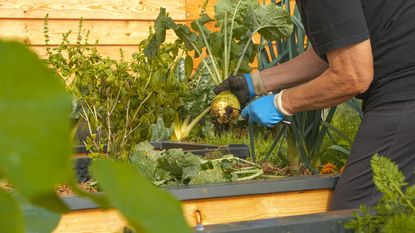Garden Wisdom: French Intensive Gardening Tips


As a beginning gardener, planning your very first growing space can be both exciting and a little confusing. Those unfamiliar with growing plants may not know what to expect. Depending upon the crop, the size and space requirements for growing vegetables can vary greatly. And for newbies growing in small urban yards or limited space, the process can be even more challenging.
But, alas, there is hope! With knowledge of French intensive garden design and some forethought, most everyone can enjoy a bountiful harvest throughout the growing season with little space.
French Intensive Gardening Tips
Large scale gardens or commercial farms are seldom at a loss for available land. However, the same cannot be said for the home gardener. While most seed packets recommend planting in single rows and with very generous spacing, this is often not a viable option. French intensive gardening, however, allows us to grow a lush green space even with backyard limitations. This particular gardening method is one that I use in my own garden for this very reason.
As the name would suggest, this type of gardening affords gardeners like myself the luxury of growing plants within very close spacing. Much like square foot gardening, growing more plants will allow for higher yields in much smaller spaces. The key in successfully doing so is directly related to preparation of the soil and garden beds before the growing season has started.
While it is possible to plant intensively in small containers, and I do that too, the best results occur from the construction of raised garden beds or raised soil beds. The French intensive method works because of the quality of the soil. Deeply worked soil, usually to a depth of at least 2 feet (61 cm.), allows the roots to easily grow and penetrate the nutrient dense combination of compost and garden soil.
When planning this garden layout, ensure the growing bed width is carefully planned. You should be able to easily harvest crops without the need to step into the bed itself where the soil could become compacted. Careful tending of this garden type will minimize the need to till or work soil in subsequent growing seasons too. Since the soil will not be disturbed, this gardening technique can help to maintain better soil structure, soil health, and reduce the amount of necessary weeding.
The French intensive gardening method also helps with diversifying space, as it frequently utilizes additional gardening techniques like interplanting and companion planting. The use of these strategies will help contribute to the overall good health of the garden and create a small ecosystem that is sure to be enjoyed by both the gardener and beneficial insects.
Gardening tips, videos, info and more delivered right to your inbox!
Sign up for the Gardening Know How newsletter today and receive a free download of our most popular eBook "How to Grow Delicious Tomatoes."

Tonya Barnett has been gardening for 13 years. Flowers are her passion. She has trasformed her backyard into a cut flower garden, which she regularly chronicles on her YouTube channel http://www.youtube.com/@tonyawiththeflowers.
-
 How To Get Rid Of Mosquitoes In The Garden: 9 Natural Ways To Make Them Buzz Off!
How To Get Rid Of Mosquitoes In The Garden: 9 Natural Ways To Make Them Buzz Off!How to get rid of mosquitoes is on the minds of people in the summer in almost every region of the world. Learn how to repel the pests without toxic chemicals.
By Mary Ellen Ellis
-
 Monkey Orchid Care: How To Grow This Fascinating Species
Monkey Orchid Care: How To Grow This Fascinating SpeciesThe monkey orchid (Dracula simia) bears a remarkable resemblance to its namesake and, with a little know-how, can be successfully grown as a houseplant.
By Bonnie L. Grant